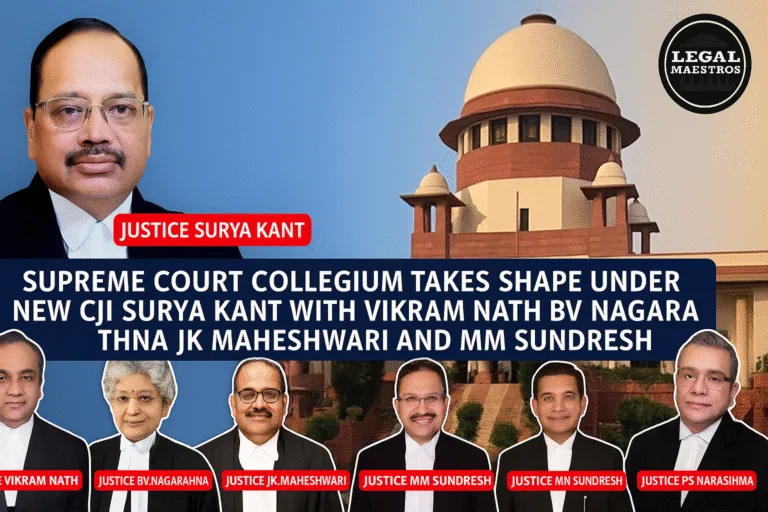
Supreme Court Collegium Takes Shape Under New CJI Surya Kant with Vikram Nath BV Nagarathna JK Maheshwari and MM Sundresh
Top court Leadership Change.
The Supreme Court of India has seen the dawn of a new era in its leadership with the swearing-in of Justice Surya Kant as the 53 rd Chief Justice of India.The change has heralded a new era in the leadership in the Supreme Court of India and it is an era likely to have a stable leadership regime of about fifteen months. The Collegium which is the body that holds the greatest power by default has been reconstituted automatically with the new Chief Justice in office to encompass the five eldest judges of the top court.
Chief Justice Surya Kant has taken over as the head of the new Collegium and four other senior judges are included in it who will be instrumental in defining the future of the higher judiciary. These members include Justice Vikram Nath, Justice B.V. Nagarathna, Justice J.K. Maheshwari and Justice M.M. Sundresh. This is a mix of judges that is having a variety of experiences of different High Courts in the country. They will majorly be tasked with the role of appointing new judges to the Supreme Court and transfer of judges between High Courts.
This reconstitution is a common yet important undertaking and occurs every time a Chief Justice retires or even when a senior member of the collegium retires. The rule of five is a unit that successfully disperses the authority of decision-making on the question of judicial nomination to the senior most legal geniuses in the nation. This group leadership will provide equity and extensive consultation in the choice of those who will interpret the constitution. Legal community has been keeping a keen eye on this new formation because they will influence the course the court will follow in the next year and half.
For any queries or to publish an article or post or advertisement on our platform, do call at +91 6377460764 or email us at contact@legalmaestros.com.
The most legally crucial aspect of the tenure of the Chief Justice, Surya Kant, is that he provided a longer period within which administrative changes could be made as opposed to some of his immediate predecessors. This is due to the fact that over a year of tenure enables the Collegium to operate on a constant vision instead of being in a state of flux. Such stability is necessary in order to cope with the problem of vacancies in the High Courts and even the Supreme Court itself. His team will now work on the recommendations that are pending and stream through on the process of appointments.
Members of the Senior Collegium
The second senior-most judge in the Supreme Court and also a major constituent in this new Collegium is Justice Vikram Nath. He was born in the Allahabad High Court and before that he worked in the Gujarat High Court as a Chief Justice of the court before being promoted to the highest court. His appointment to Collegium is however critical since he is the next to assume the Chief Justice of India after Justice Surya Kant retires in February 2027. His background in handling high judicial dockets will be useful during the deliberations of the Collegium.
B.V. Nagarathna is also a judge accompanying him who has distinctive and historic status in the Indian judicial hierarchy. In 2027, she will be the first female Chief Justice of India, but her term will be short lived. She brings a crucial point of view as she is the voice of women in the uppermost levels of judicial decision-making. Justice Nagarathna has been credited with her firm opinions about civil liberties and her eloquent rulings that tend to be concerned with social justice and gender equality.
These two judges, together with the Chief Justice, also constitute the smaller Collegium of three men. This small population has its own and particular work which is not part of the entire body of five members. Although the entire five person group determines whether to promote the judges to the Supreme Court, the three person group deals with appointing and moving of the judges to the High Courts. This separation of duties makes sure that the huge responsibility of controlling the High Court judiciary is provided with the top three judges.
The relationship between Justice Nath and Justice Nagarathna will be significant since they both will become the Chief Justices. Their association with CJI Surya Kant will tone down the administrative aspect of the Supreme Court. As they both possess long tenure that they can serve before other judges, its impact on the policy adopted by the Collegium on appointments is expected to be felt in several years. Their presence will make sure that the vision of the long term of the court will be reflected in the present-day decisions.
The More Recent Members of the Decision Making Body.
Justice J.K. Maheshwari is a man with experience of central India that has rich experience in the Collegium table. His home court is the Madhya Pradesh High Court and he is the former Chief Justice of Andhra Pradesh as well as Sikkim High Courts. The fact that he is a top five judge creates a new outlook in the process of selection. His experience in managing various legal cultures across various states makes him have a practical approach of what a judge of a High Court should possess.
Justice M.M Sundesh, the fifth member of this elite group, brings on board additional regional diversity to the panel. Being a former judge in the Madras High Court, his representation is bound to make sure that the southern region of India has a good representation in the supreme decision-making body. Justice Sundresh is a specially reputed calm judiciary and knowledgeable in different subsets of civil and criminal law. He will have a role to examine the potential candidates and make sure that merit is the main factor in terms of selection.
Justices Maheshwari and Sundresh also brought the quorum necessary to the Collegium. According to the set legal norms, the Collegium is not able to meet or make recommendations in case it is not complete. The Supreme Court is now in full blast to be able to resume its administrative functions with their formal admission into this group by the seniority convention. Their votes are counted just the same as the vote of the Chief Justice during the final selection and as such the internal process is democratic in nature.





